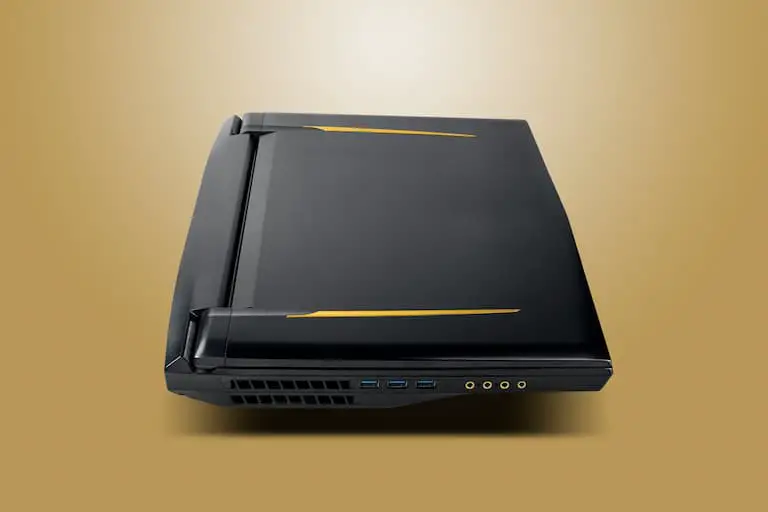Constant button smashing and long hours of usage can physically wear down your gaming laptop. Whereas frequently installing new games and software can make the OS bloated. This is why it’s absolutely essential to maintain your laptop from time to time.
Here are 8 essential steps to maintain a gaming laptop:
- Buy a cooling pad for your laptop.
- Give your gaming laptop frequent breaks.
- Reduce strain on your laptop’s battery.
- Clean external components with isopropyl alcohol.
- Clean internal components with compressed air.
- Keep software up to date.
- Buy hardware upgrades.
- Buy a gaming laptop built to last.
This might seem like a lot at first, but taking all of these steps will help ensure your gaming laptop stays healthy for a long time. I’ve also provided detailed insight on how to go through each recommended step and how it helps increase your laptop’s longevity.
1. Buy a Cooling Pad for Your Laptop
Heat is a big contributing factor to a computer wearing down over time. This is especially true in the case of laptops, which are particularly prone to overheating due to their compact nature. Powerful hardware handling intensive tasks also means more heat generated, and it doesn’t get more intensive than a gaming laptop running heavy programs.
Your laptop undoubtedly has an internal cooling system, but that doesn’t mean it can’t overheat. Even the best cooling fans can be overworked by prolonged strain, such as from playing video games for hours at a time.
That’s where cooling pads come in. These pads have fans in them that, when placed under a laptop, help keep it cool. They usually plug right into a USB port and share the laptop’s electricity, making them cheap and efficient to run. They’re also quite portable since they’ll fit anywhere a laptop will.
If you’ve never bought a cooling pad before and aren’t sure what’s right for you, this LIANGSTAR Laptop Cooling Pad (available on Amazon) is affordable, quiet, and features six cooling fans for maximum performance. It also sports an attractive design with vibrant LED lights, guaranteed not to take away from your gaming setup.
2. Give Your Gaming Laptop Frequent Breaks
While we’re on the topic of heat, another thing your laptop will appreciate in the long run is giving it time to rest. Even with the best cooling pad money can buy, a laptop can still overheat and wear out over time if you push it too hard.
If the underside of your laptop feels hot, or if its internal fan is running louder than usual, these are good signs it’s time to take a break from whatever you’re doing and let it cool down for a while. Not only will overheating damage your computer, but it can also slow down any programs you’re trying to run.
3. Reduce Strain on Your Laptop’s Battery
As surprising as it might be, leaving your laptop plugged in all the time can also wear it out.
When the battery is fully charged, more electricity is housed inside, putting more strain on the battery and generating extra heat. This – along with the heat generated from being in a constant state of charging while in use – can contribute to the laptop’s battery wearing out over time. This effect is more pronounced in some laptops than others, but constant heat is never good for them. If you’ve ever had a laptop’s battery life shrink dramatically over time, this might have something to do with it.
Fortunately, the fix for this is as simple as giving your laptop a break from the charger when it doesn’t need to be plugged in, especially if it feels hot already. Turning your laptop off when you’re not using it can help mitigate strain on the battery as well. While you can’t entirely prevent the battery from weakening over time, and the difference made by trying to relieve strain on it might be small, it can add up over time.
You can also limit the maximum charge allowed for the batteries of some laptops. Preventing it from reaching 100% charge will lower the amount of heat generated. You may be able to find an option for this under your laptop’s power or battery settings, but this varies between devices. As such, you should check if your model has such a setting.
4. Clean External Components With Isopropyl Alcohol
Things get dirty over time. Even if you’re a clean person who takes good care of your laptop, it’s going to get dirty eventually. Something like a smudge on the screen won’t hurt your device’s performance, but little bits of dust and grime can build up in problematic places over time if you don’t do regular cleaning.
To clean the outside of your laptop, you will need a bottle of isopropyl alcohol and something to wipe it down with. Microfiber cloth is a good idea to use because it’s gentle and safe on screens, but alcohol wet wipes do a good job too. Try to avoid using other cleaning solutions as they could damage internal components.
The steps to properly cleaning your laptop case are as follows:
- Unplug the laptop. This is important because you don’t want the device to be on while you’re cleaning it with a wet cloth. Alcohol won’t normally cause damage to sensitive electronic components, but it’s never a good idea to put liquids near a computer with a live current of electricity running through it. You can remove the battery as well if you want to be extra safe.
- Wet your cloth with alcohol, making sure not to soak it. Do not spray or pour alcohol directly onto the computer, as saturating it with large amounts of liquid can still cause damage.
- Wipe down your laptop’s screen and keyboard gently as these are often fragile components. You can put a little more elbow grease into cleaning the rest of the casing, but try not to be too rough with it.
- Use a cotton swab to clean the cracks and crevices, such as underneath the keyboard. This is an optional step you can consider if you can’t reach these places with a normal piece of cloth. Just be careful not to stick anything inside of the computer. I’ll discuss how to handle the internal cleaning in a moment.
- Turn on a fan and let your laptop dry. Don’t turn it back on until any lingering alcohol has evaporated.
Now your laptop should look good as new from the outside. But as we all know, it’s what on the inside that matters. So let’s quickly see the most efficient way to clean your laptop’s internal components.
5. Clean Internal Components With Compressed Air
Cleaning the inside of a laptop is very different from cleaning the outside, mainly because most of the sensitive components are on the inside.
Laptops aren’t nearly as easy to take apart as desktop computers, and some are made to prevent people from opening them up. With all the compact and sensitive parts, they just aren’t made to have people poking around inside of them. Some manufacturers even consider this a warranty-voiding act.
Alas, dust loves to get into inconvenient places, and all the little crevices and holes in a laptop case are no exception. But if you can’t get inside of it, how are you supposed to clean it? There are a few ways, but the simplest one is with a can of compressed air.
The good news is that this process is actually simpler than cleaning the surface of your laptop. All you’ll need is a can of compressed air – any will do. Just point the nozzle at every vent, hole, crack, or crevice you can find, and give the can a spray.
While you’re at it, you can use this method to clean under the keyboard too. If you had difficulty getting to this area before, the compressed air might help.
6. Keep Software Up to Date
Up till now, I’ve been talking about the hardware maintenance of your gaming laptop – keeping it cleaner and cooler. Now, let’s focus on the software maintenance part and why it’s important to keep it up to date.
Even an expensive and well-kept gaming laptop will be rendered obsolete quickly if you don’t update the software regularly. This is especially true if you want to use it for its intended purpose – playing video games.
To check for available updates, all you need to do is go to your computer’s search bar and type “update,” then click on “Check for updates.” This will bring you to your computer’s update settings.
Here, you can see things like your computer’s most recent updates and check for any pending updates or downloaded updates that need to be installed. All you have to do is click on the button that says “Check for Updates”, after which it should handle everything for you.
If you do have auto-update on and working properly, your laptop will notify you when new updates have been downloaded and are ready to install. You might need to restart your computer to install some updates, but that’s it.
7. Buy Hardware Upgrades
Normally, you’d want to replace a computer’s hardware over time to keep it up to date. However, you may recall the previously mentioned slew of problems that come with trying to open up a laptop. Without professional assistance, it’s typically hard, if not impossible, to replace laptop parts yourself.
The battery is among the few things you can easily replace, as long as you’re able to find one that works with your laptop. Replacing an old battery can help reduce overheating and dramatically increase your laptop’s screen-on-time when unplugged.
Other important components
Other important components you might be able to upgrade are the RAM module and hard drive. There’s just one problem: to get to these parts, opening up the back panel of the laptop is necessary. Nonetheless, there will come a time when this is necessary if you want your laptop to remain functional.
There’s no shame in asking for professional help with something like this if you don’t want to risk voiding your laptop’s warranty or are worried about doing something wrong. With that said, if you’re interested in upgrading your laptop’s RAM and hard drive, the process isn’t very complicated.
Keep in mind that this is all assuming your laptop’s manufacturer made it possible to do any of this in the first place. Sometimes, they make sure everything’s glued or soldered together and impossible to get to. In such an event, you will have to contact a professional.
8. Buy a Gaming Laptop Built To Last
One of the biggest factors in the lifespan of any laptop is how well-built it is. Quality casing and internal components can be pricey, but a high-end gaming laptop is likely to last at least twice as long as a cheap one, making the extra expense well worth considering.
However, you don’t just want to look for an expensive laptop since not all computers are necessarily worth their price. Doing proper research is vital for ensuring you get a gaming laptop with high-quality parts.
Final Thoughts
A lot can go into maintaining a gaming laptop and keeping it running smoothly. You need to make sure it doesn’t overheat, buy a cooling pad to keep the temperature low, and routinely invest time to clean dirt and debris that might get logged inside the crevices of your laptop. And that’s just maintaining the laptop’s hardware bits. You also need to take care of the software, making sure that the system is up to date with the latest firmware, OS updates, drivers, etc.







